

Mark
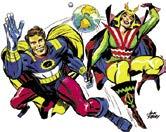
(919) 449-0344.
at Raleigh, NC.
Send address
to Back Issue, c/o TwoMorrows, 10407 Bedfordtown Drive, Raleigh, NC 27614 Michael Eury, Editor Emeritus. Roger Ash, Editor-In-Chief. John Morrow, Publisher. Editorial Office: BACK ISSUE , c/o Roger Ash, Editor, 2715 Birchwood Pass, Apt. 7, Cross Plains, WI 53528. Email: rogerash@hotmail.com. Eight-issue subscriptions: $108 Economy US, $161 International, $39
Please send subscription orders and funds to TwoMorrows, NOT to the editorial office. Cover artwork by Sal Buscema. TM & © Marvel Characters, Inc. All Rights Reserved. All editorial matter © TwoMorrows and Roger Ash, except Terry’s Toons © Terry Austin. Printed in China. FIRST PRINTING
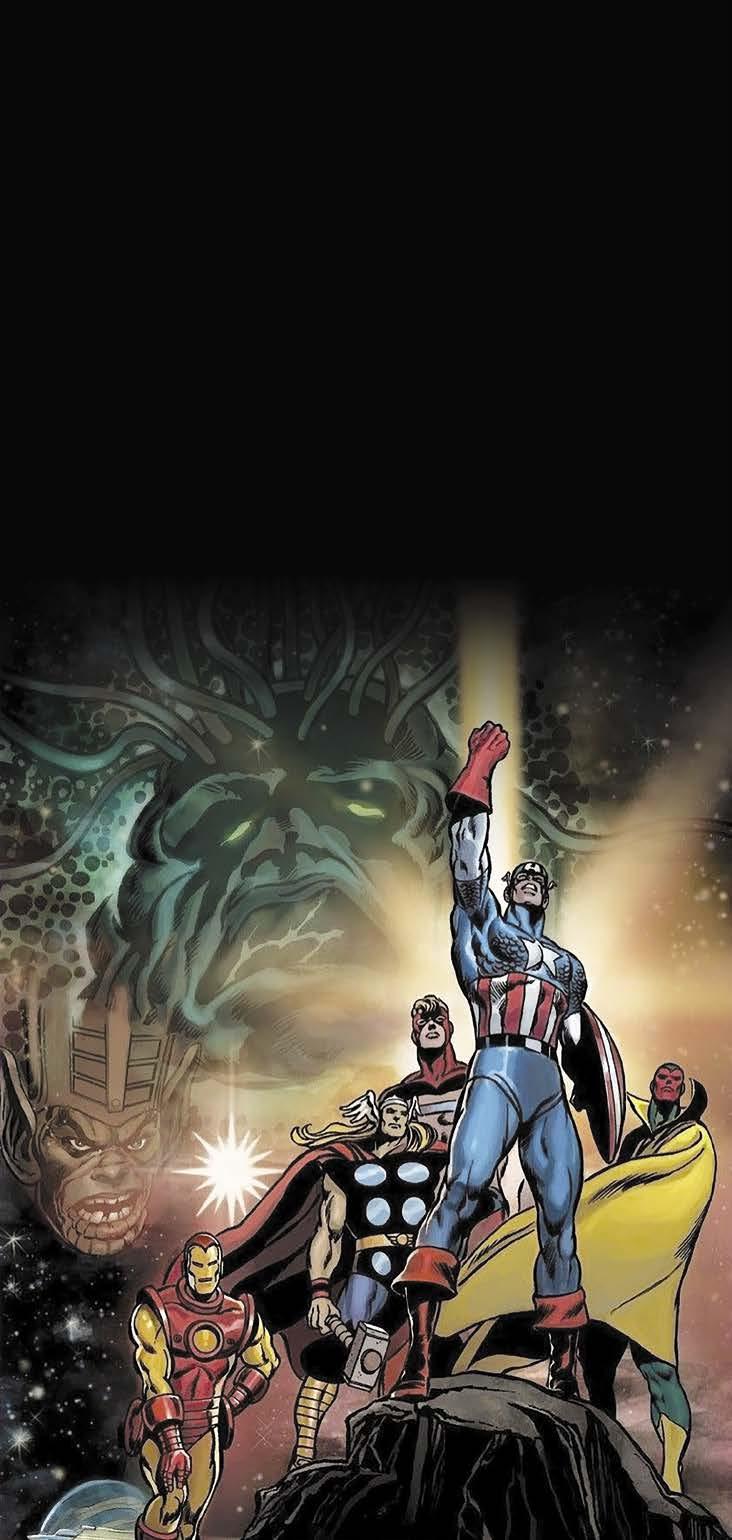
by Jarrod Buttery
Rivalries don’t get much bigger than between Galactic Empires. As one of Marvel Comics’ linchpins, “The Kree-Skrull War” owes its origins to a rich, shared universe.
CELESTIALS
Scene-setting: Many of the characters featured in “The Kree-Skrull War” were created by Stan Lee and Jack Kirby, but later creations—the Celestials— belong to Kirby alone. Eternals #1 (July 1976) reminds us that: “Every myth and legend to emerge from the distant past points to a strange visitation from the stars!!” The blurb for the following issue promises “Celestials From Space” and, indeed, we (and archaeologist Dr. Daniel Damian, and his daughter Margo) meet the Celestials (one of them at least) in Eternals #2 (Aug. 1976).
Marvel’s first volume of the series What If? occasionally featured back-ups entitled “Untold Tales of the Marvel Universe.” Issue #23 (Oct. 1980) expands upon Kirby’s details. In “The First Celestial Host,” writer Mark Gruenwald explains how the Celestials voyage across the galaxy seeking worlds which have birthed life with the potential for intelligence. Gammenon the Gatherer collects indigenous lifeforms. Ziran the Tester irradiates the specimens, altering their genetic blueprint, creating creatures with unstable genetic phenotypes—creatures that will one day be called Deviants. Meanwhile, Nezzar the Calculator tests specimens for durability and longevity, creating beings possessing the ability to tap the energy of the cosmos—a new breed which will one day be called Eternals. With a name to strike terror into all, Oneg the Prober imbues specimens with a latent gene and allows that species to mature naturally— one day becoming Human.
SKRULLS
The Marvel Age of Comics commenced with Fantastic Four #1 (Nov. 1961) and we were introduced to Mister Fantastic (Reed Richards), the Invisible Girl (Susan Storm), the Human Torch (Johnny Storm), and the Thing (Ben Grimm). Superheroes were making a comeback but Marvel—then primarily known for monster and fantasy comics such as Strange Tales and Journey Into Mystery—continued to hedge its bets. The cover to FF #1 prominently portrayed a monster emerging from beneath a city street. Heck, one of these new super-characters looked like a monster himself!
In their second issue, the Fantastic Four—still depicted in civilian clothes—encounter “The Skrulls From Outer Space!” The issue opens with the fabulous foursome apparently committing crimes! Have they turned evil in only their second
Neal Adams’ cover art for a 2019 “Kree-Skrull War” reprint collection.
TM & © Marvel Characters, Inc.
(top left) The Celestial Tefral is featured on the cover of The Eternals #7. Art by Jack Kirby and John Verpoorten.
(top right) The Skrulls debuted in Fantastic Four #2.
Art by Kirby and George Klein.
appearance? No, they are being impersonated by shape-shifting aliens called Skrulls. This conniving quartet is the advance guard for an alien invasion force—but they must first discredit their only potential opposition: the Fantastic Four!
It’s clearly shown that—while Skrulls can change their shape—they have no real powers of their own. The faux-Thing uses a detonator (not strength) to destroy an oil rig. The larcenist “Imitation Girl” simply shrinks out of sight, rather than becoming invisible. The phony Torch uses a jetpack (and some sort of protective outfit), and the elasticated ersatz Mr. Fantastic explains, “As for me, I needed no special devices! For it’s an easy matter for me to alter my body in any way I desire!”
The true FF are arrested, but they escape and uncover the counterfeit culprits. We see that the four Skrulls are captured and tied up. The real FF use the Skrulls’ shuttlecraft to fly to the Skrull mothership orbiting Earth. Our FF pretend to be



the Skrull imposters reporting to their superiors. Our Mister Fantastic presents clipped art from Strange Tales and Journey Into Mystery as proof of Earth’s defenses. Aliens were seemingly more gullible in the 1960s, and the panicking Skrull commander orders that the invasion force leave Earth forever!
After receiving the Skrull medal for bravery, for volunteering to stay behind, our FF return to Earth. We see that there are only three Skrulls at their old hideout, but Reed postulates that, “The fourth one is on his way to another galaxy now with the rest of his invasion fleet!” Reed tells the Police Chief that he has an idea to deal with the three remaining Skrulls. Reed orders the Skrulls to change into cows and subsequently hypnotizes them so that they will forget they’re Skrulls. And they never caused any trouble ever again…
To be fair, in Fantastic Four Annual #17 (1983), Sue tells us that: “Reed’s examination of the captured Skrulls had determined their eyes were much less complex than ours, rendering them incapable of more subtle visual perceptions.” She also acknowledges that, “Although one of the masqueraders escaped, we were able to capture the other three and learn their plans to invade and conquer our planet.”
By definition, a quadrant is one of four parts: a quarter. But Skrulls are so devious, their home planet is in the FIFTH quadrant of the Andromeda Galaxy, as we discover in Fantastic Four #18 (Sep. 1963). Emperor Dorrek VII is seething that his invasion of Earth was thwarted by the Fantastic Four. He has commissioned his scientists to create a Super-Skrull, who possesses all the powers of the FF—and more!
The Super-Skrull certainly lives up to his name by overpowering our heroes. Correctly deducing that someone so powerful must be tapping an external energy source. Reed constructs a “jammer” to block this energy source, and the Super-Skrull is defeated. Disguised as the Invincible Man, the Super-Skrull returns in FF #32 (Nov. 1964) and is returned to his home planet. Tragically, Sue and Johnny’s father—Dr. Franklin Storm—is killed by a Skrull booby trap. Our heroes travel to the Skrull homeworld in FF #37 (Apr. 1965), seeking justice. There, Sue saves the life of Emperor Dorrek’s daughter—the Princess Anelle—and Dorrek swears off conquering Earth.
The shape-changing ability of the Skrulls is occasionally attributed to their deviant genetic code. In Silver Surfer #5 (Nov. 1987) it is specifically stated that the Celestials visited the Skrulls in their early infancy as a race and experimented upon them. The resultant shape-shifting deviants matured into two strains: the Skrulls that we know, and the Dire Wraiths. The Deviant Skrulls drove away the Wraiths and exterminated the Eternal and Latent Skrulls. Canonically, the Skrulls of the Marvel Universe are the Deviants of their race.
This Walter Simonson/Tom Palmer cover graced an early collection of “The Kree-Skrull War.”
TM & © Marvel Characters, Inc.



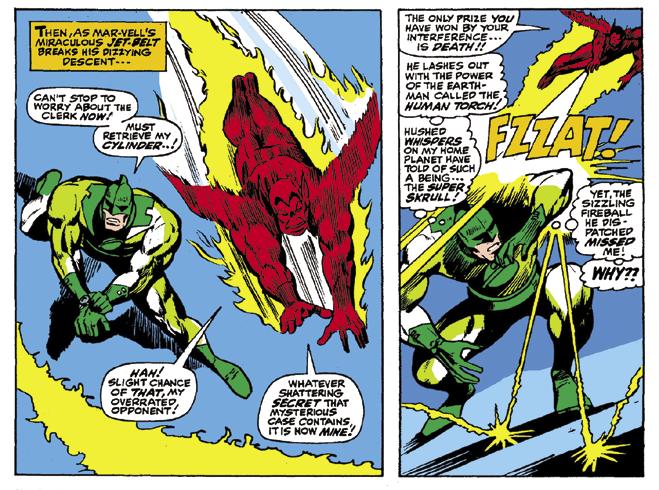
THE KREE
Dr. Daniel Damian discovers an ancient alien outpost on a South Pacific Island, in Fantastic Four #64 (July 1967). In doing so, Damian awakens Inter-Galactic Sentry 459, whose mission is to protect the outpost under the orders of its alien masters—the Kree. The Sentry engages a vibrational screen around the island. The Fantastic Four investigate and are attacked by the Sentry, who proclaims, “This area has been designated as a Space Port, to be used only by the Kree race!” During the battle, some part of the alien equipment is damaged causing the entire outpost to explode. The Fantastic Four escape (rescuing Dr. Damian and his assistant), while the Sentry makes a final report…
Fantastic Four #65 (Aug. 1967) opens with our heroes being telepathically contacted by the Supreme Intelligence of the Kree, who blames them for the destruction of his outpost and loyal Sentry. The Supreme Intelligence—simply depicted as a green head with tendrils—declares that the FF will be sentenced by Ronan the Accuser.
Ronan is an extraordinarily powerful being. Armored, cybernetically-enhanced, and over sevenfoot tall, he is armed with the Universal Weapon, which can do, well, anything Stan and Jack can imagine. Ronan (Caucasian in this debut appearance) accuses and sentences the FF to the extreme penalty. The FF seem outmatched until Ben wrestles Ronan to fall upon his own weapon—just as it discharges— causing Ronan to be teleported away. Reed mulls that, “The Kree now know that they are dealing with an intelligent race—and a fighting race!”
CAPTAIN MARVEL
“Stan Lee didn’t want to co-create a hero named Captain Marvel—but he did, just the same. Because Martin Goodman told him to,” writes Roy Thomas in his introduction to Marvel Masterworks: Captain Marvel Vol 1. “Goodman’s directive was, as Stan told me at the time, to devise a hero named Captain Marvel; the details were left to him. Stan, I recall, was not thrilled about doing this. The original [Fawcett Publications] Cap had been so popular that he didn’t want to create a hero with the same name. But Stan at that stage was a good soldier—so he informed artist Gene Colan that he was going to be drawing a new hero called Captain Marvel.
“The Lee/Colan Captain Marvel was created an alien—one of the star-spawned Kree, whose android Sentry and then avenger Ronan the Accuser had popped up in FF #64-65 only a few months before, the brainchild of Stan and Jack Kirby; so, the Kree were on his mind at the time. Why shouldn’t this
(top) The Fantastic Four encounter the Supreme Intelligence of the Kree. Art by Kirby and Sinnott. (middle left) The Fantastic Four face Ronan the Accuser. Art by Kirby and Sinnott. (middle right) Captain Marvel debuts in Marvel Super-Heroes #12. Cover by Gene Colan and Frank Giacoia. (bottom) Captain Marvel faces a familiar foe in the second issue of his own series. Art by Colan and Vince Colletta.
TM & © Marvel Characters, Inc.
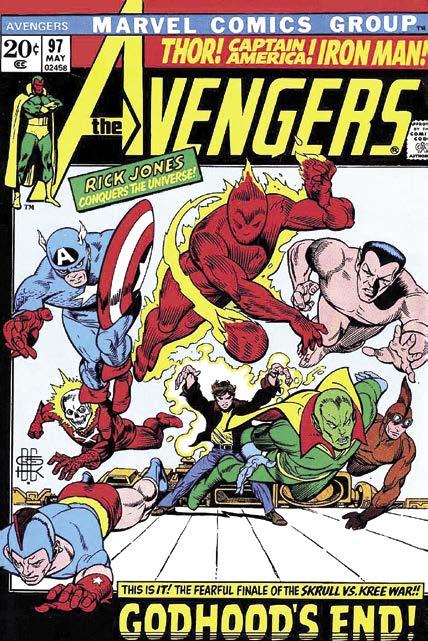
#205 (Apr. 1979) we are told that the Skrulls are losing their war against the Kree and seek to procure the Living Computers of Xandar. In FF #209 (Aug. 1979), Emperor Dorrek VII is assassinated by his wife R’Klll. When Galactus consumes the Skrull Homeworld in FF #257 (Aug. 1983), R’Klll and daughter Anelle are seemingly killed.
Prior to this, both R’Klll and the Supreme Intelligence are consulted by Shi’ar Empress Lilandra concerning the fate of the Phoenix—in X-Men #137 (Sep. 1980). The Skrulls and Kree both send representatives to observe the trial in the Blue Area of Earth’s moon. Unsurprisingly, Skrull Warlord Raksor and Kree Colonel Bel-Dann end up fighting each other.
The Inhumans move their Great Refuge to the Blue Area of the moon in Fantastic Four #240 (Mar. 1982). In Fantastic Four Annual #18 (1984) we discover that Raksor and Bel-Dann are still fighting! Surprisingly, for two such proud races, the Supreme Intelligence and Empress R’Klll admit that their eternal war is draining on both empires. Thus, they propose that Raksor and Bel-Dann act as champions—with the winner of their combat determining the ultimate victor in the eons-old war of empires.
It’s a noble idea but—unfortunately—the continuing battle is a serious threat to the Great Refuge. Consequently, Reed Richards and Black Bolt devise a plan for the Fantastic Four and the Inhuman Royal Family to take the fight to Raksor and Bel-Dann. The aliens are forced to team up to defeat our heroes (who conveniently throw the fight). The Watcher declares the combat ended, declaring that Raksor and Bel-Dann are both winners and it is the Earthlings who have lost. The Kree-Skrull War is finally over—concluding in a draw.
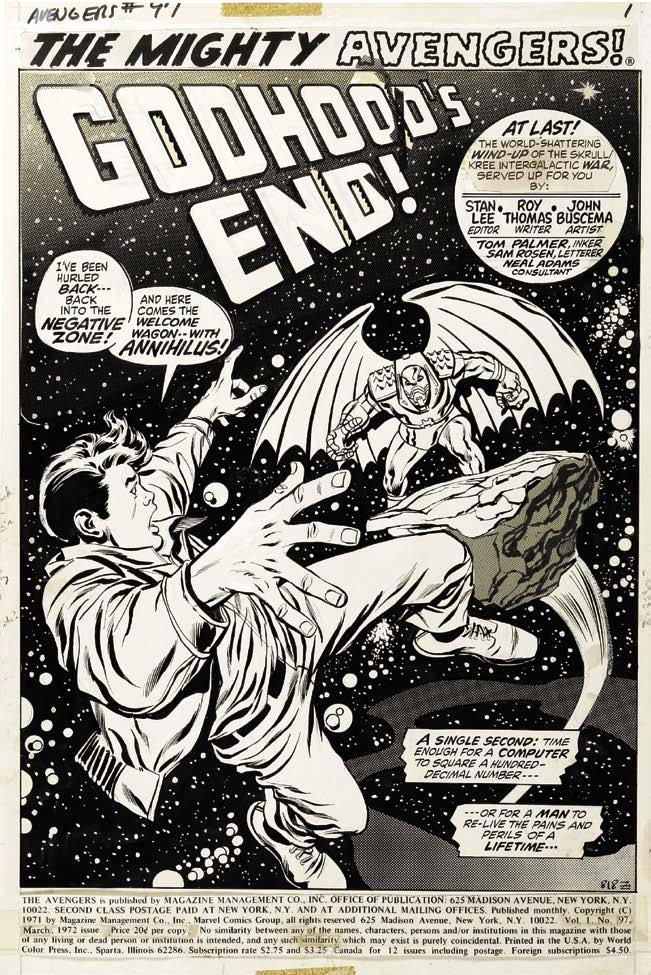
Until it starts again in Silver Surfer #6 (Dec. 1987).
Years later, in Young Avengers #10 (Mar. 2006), we learn that the young hero Hulkling is the son of Princess Anelle, and that his true name—his royal title—is Dorrek VIII. In the following issue, we learn that his father was Mar-Vell, and that Hulkling was conceived during the Kree-Skrull War. Anelle’s father—Dorrek VII—was furious about the child’s heritage, and so the infant was smuggled off-world and raised on Earth. As a Kree/Skrull hybrid of royal blood and extraordinary mettle, Dorrek-Vell has unified the two empires at last.
THIS BEACHHEAD EARTH
Although he’s spoken about it many times, Roy Thomas kindly shared some thoughts with BACK ISSUE : “I’ve always credited Raymond C. Jones’ novel This Island Earth as the inspiration for the idea of the Earth caught between two alien space races at war. However, while writing the first volume of my autobiography, I was reminded
(left) The final chapter is here.
Art by Gil Kane and Bill Everett. (right) John Buscema and Tom Palmer’s stunning splash page for Avengers #97. Original art scan courtesy of Heritage Auctions (www.ha.com). TM & © Marvel Characters, Inc.


by Brian Martin

Ladies and gentlemen, let’s get ready to ruuumble! Tonight’s bout is scheduled for eight rounds and has a dramatic twist to it! Tonight’s two combatants are sisters, and the prize is an entire planet!
LET’S MEET OUR COMPETITORS
Before the fisticuffs begin, we’re going to introduce the fighters. In the purple corner, hailing from the planet Tamaran, we have Princess Koriand’r. Introduced, along with the other members of the New Teen Titans, officially in the special insert in DC Comics Presents #26 (Oct. 1980), the princess arrived a little earlier in the DCU timeline very soon after within New Teen Titans #1 (Nov. 1980). A little different than the other two characters created from whole cloth by Marv Wolfman, George Pérez, and Len Wein, those two being Raven and Cyborg, Starfire was given a less completely detailed history in the early issues of the title. Though we find out some about her home planet, we are not given any information about her sister who is her opponent in our match. [For a detailed examination of the early days of Starfire, please refer to James Heath Lantz’s article in your copy of BACK ISSUE #123 which gives a hero history of the Tamaranian princess]. This was understandable at the time, as Raven’s backstory was integral to the creation of the Titans group as well as the storyline that encompassed the first six issues of the title, while Cyborg’s was the foundation for issue #7.
In the black and silver corner, also from Tamaran, is Queen Komand’r. Like her sister, she debuted relatively early in the New Teen Titans narrative. The final page of issue #22 (Aug. 1982) introduces her in very dramatic fashion with a full page shot as she announces her intentions towards her sister.
ROUND 1: TEACH YOUR CHILDREN
Following up on her debut, Blackfire begins her assault on her sister, and by extension Kory’s compatriots in NTT #23. But before we get to that, we have a couple of rounds that take place chronologically earlier than this.
Published the same month as NTT #23, was the fourth and final issue of Tales of the New Teen Titans, a series that capitalized on the success of the young team and spotlit the three new Titans and the rebranded Changeling, each having their history told in one issue.
Starfire’s turn to shine begins the first round of our tussle extremely early as the two sisters are pitted against each other from birth! Komand’r ’despised’ her sister upon arrival and quickly made that contempt manifest by killing Koriand’r’s first pet. It should be noted that, though she reserves a special type of hatred for her sister, even as a small child Komand’r is shown to be full of hate
Blackfire and Starfire battle to the death on the cover of New Teen Titans Annual #1. Art by George Pérez.
TM & © DC Comics.
(top) Starfire’s history is revealed in Tales of the New Teen Titans #4. Cover by George Pérez. (bottom) A beautiful Portrait of Starfire from Tales of the New Teen Titans #4. Art by Pérez and Ernie Colon. TM & © DC Comics.

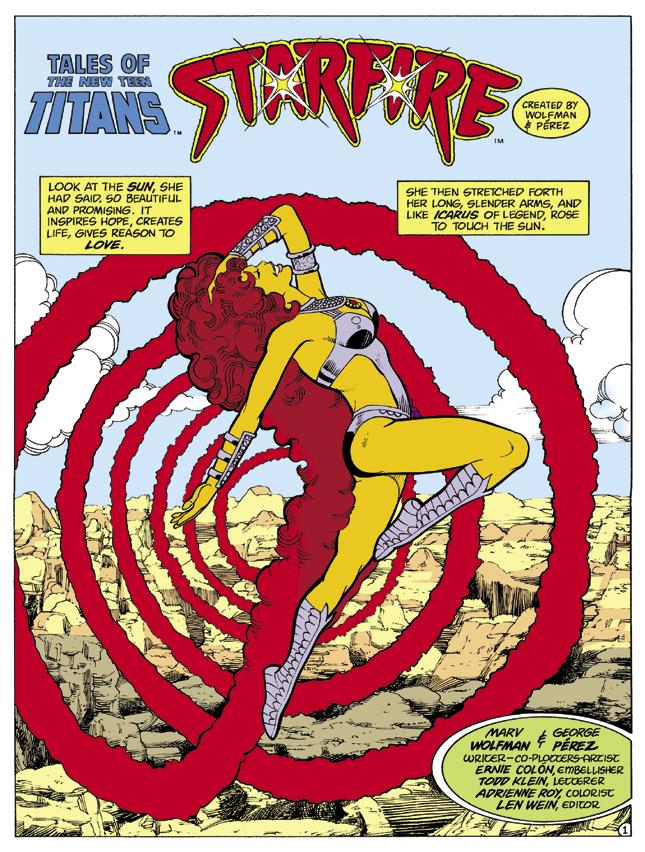
for almost everything and everyone around her. Born without the ability to fly shared by most Tamaranians, this labels her as a freak, unfit for leadership. This development might be considered the genesis of all the hatred she would exhibit as she grew. Blackfire is the decisive winner of the first round as, supposedly due to her sister laughing at her handicap, she bloodies her fists…. against her sister’s face! Starfire relates that the gulf was more like a chasm as the two sisters did not even speak to each other as they grew up.
ROUND 2: SCHOOL’S OUT
The same issue details the next fusillade in their conflict. Those familiar with the Vega star system as depicted in DC comics, mostly in NTT and Omega Men, know that a number of still free planets in the system were at war with the evil Citadel. The children of royal families on these planets are sent off to the planet Okaara to be trained by that world’s Warlords. The sisters from Tamaran are no exception. It should surprise no one that the two sisters have diametrically opposite attitudes towards this training. Komand’r sees it as a glorious opportunity to learn how to kill, while Koriand’r is overcome with awe by the mystical aspects of the Warlord’s legend.
Under the Warlord’s training regimen, the younger sibling learns compassion, but also that war is sometimes a necessity and that you must be proficient in those arts as well. The senior daughter only wants to learn to kill.
As their training nears an end, they face their final exam, if you will. The Tournament. Armed with weapons and mounted on fantastic beasts, the sisters are pitted against one another in battle. Komand’r breaks the rules and slices the leg of Koriand’r’s mount, sending her to the ground. She then proceeds to mercilessly drag her sister behind her. Starfire finally frees herself and as her opponent pivots to renew her assault, Koriand’r knocks her off her saddle. And sends her plunging into a gorge.
Horrified, Starfire flies and saves her sister. Mortified by what she feels is the humiliation of being rescued, Komand’r proceeds to beat her sister to a pulp and draws her sword to kill her. The Okaaran’s intercede, disgusted at the pure evil before them. Komand’r is expelled, but not before vowing revenge.
On the physical side of things, Komand’r is, of course, the winner of this round. On a psychological scorecard, it is not quite so clear. One sister plunges down a slippery slope on the path to hate, while the other is taught the first lesson of, what must be conceded to be many, in the course of learning what her older sister truly is. This knowledge will be put to good use in later rounds as we will see.
ROUND 3: BACK IN BLACK
Just a small aside before we continue. We are still examining events from that one Tales issue. Detailing as it does the foundations, and early rounds of our conflict, we do have to score the events therein quite carefully. We will move on though, rest assured.
Komand’r did come back. And not long after. And with friends. Now allied with the Citadel, she provides them with information that allows them to successfully invade Tamaran. It is not a decisive victory however, and a truce is soon called. The punchline to the agreement is that Princess Koriand’r is given over to become a slave of the Citadel. And into the care of her sister. Basically,

rented out by the year, Starfire would always return to the, ahem, tender loving care of her sibling when her year of servitude was done. Only to be subjected to further degradations while back in her sister’s clutches. Clearly this round is won by Komand’r.
ROUND 4: THE POWERS THAT BE
Our deep dive into Tales #4 concludes with a pivotal occurrence in the life of both sisters. As Kory is once again returned to Komand’r’s clutches, their ship is attacked by Citadel enemies, the Psions. Dedicated purely to science, the aliens decide to perform experiments upon the two sisters to ascertain the extent of their races’ Sun absorption ability that allows them to fly. A fortuitous Citadel attack frees the Tamaranians at a crucial juncture. But not before an unforeseen but significant side effect occurs. The sisters are imbued with Starfire’s signature superpower, the ability to fire energy bursts from their hands. Since she stayed connected to the machine longer, Blackfire actually becomes the more powerful of the duo.
Of course, once again Koriand’r shows compassion towards her sister, freeing her from the machine. And Komand’r berates her sibling for it and tries to kill her. The Citadel raid separates the sisters and puts the younger daughter in the position we find her in at the beginning of New Teen Titans #1. Since that event led to such positive gains in her life, we will give Koriand’r the victory in this round on points.
As we mentioned, both Raven and Cyborg had their histories well fleshed out early in the new Titans series. BACK ISSUE asked writer Marv Wolfman if he had Starfire’s background fleshed out that early as well. “I had lots of Kory’s background sketched out. I like detail but don’t want to overdo it to give room

for making changes when necessary.” To go into further detail, Wolfman told the Comics Journal in their seventy-ninth issue (Jan. 1983), “The Starfire storyline on Tamaran, which is the last one of the miniseries, almost all of which I had worked out even before the first issue came out. I knew what she had done, how she had escaped, how she was tortured, all the things with her sister. I wanted someone who had gone through all this and still emerged pretty much an optimist.”
While we are dealing with the genesis of these characters, George Pérez commented on one of his regrets when it came to the look of Blackfire when he was interviewed in Comics Interview #50 (1987). “The one thing I regret from other artists’ point of view is that I gave her such a harsh face; I wanted it attractive yet strong, and many people, if you don’t get those angles of that face right, she comes out ugly—and Blackfire is not an ugly woman, she’s just very harsh looking.” And acting, if Mr. Pérez doesn’t mind us interjecting that.
(left) Blackfire has Starfire right where she wants her on the cover of New Teen Titans #23. Art by George Pérez and Dick Giordano. (right) Blackfire makes her presence known at the end of New Teen Titans #22. Art by Pérez and Romeo Tanfhal. TM & © DC Comics.
by Mark Arnold

Much has been said about the love triangle with Archie, Betty, and Veronica. What hasn’t been said as much is that Archie Andrews has a rival in the name of Reggie Mantle, who not only competes with Archie on a popularity level and on a sports level, but he also competes with Archie on this love triangle level.
Though both Betty and Veronica have gone out with Reggie from time to time, both of their hearts are really sold on Archie. As such, Reggie sometimes has a hard time getting a date and, as a result, dangerously goes after and dates Moose’s girlfriend, Midge, from time to time.
Archie: A Celebration of America’s Favorite Teenagers by Craig Yoe says about Archie, “Archie is the average American teenage boy, with an average mom and dad, living in the average town of Riverdale. The difference is that Archie has two girlfriends! What’s more, they’re always fighting over him. He is forever caught in a love triangle between the sweet girl next door, Betty, and the uber-rich girl in the mansion, Veronica. He’s always juggling the two girls, which keeps him in endless trouble. He’s clean cut, well-mannered, and wellmeaning, but is extremely impulsive and easily distracted. He brings home average grades and plays on the school sports teams. He has had assorted part-time jobs to earn date money.”
Archie’s full name is Archibald Andrews. His nickname is Chick. He is of Scottish ancestry. He plays lead guitar and is the lead singer of his band called The Archies. His first appearance was in Pep Comics #22, December 1941.
Archie: A Celebration of America’s Favorite Teenagers by Yoe says about Reggie, “Reggie is the ultimate wise guy; he is always looking to pull a fast one over on someone (and that someone is usually Archie). He will be the first to tell you how handsome he is and he believes that he is the best at everything. With his all-around athletic abilities and handsomeness, he really thinks of himself as the school hunk. Despite his good looks, he often has trouble getting dates because girls can usually pick up on what a louse he is. Archie is his rival in almost every field of endeavor, especially where Veronica is concerned. Reggie is constantly pulling pranks, which drives the whole gang crazy.”
Reggie’s full name is Reginald Mantle III. He has some Native American ancestry. His nickname is “I-Love-Me.” His self-appointed nickname is “Mantle, the Magnificent.” His crushes are Veronica Lodge and Midge Klump (Moose’s girlfriend). Reggie plays bass guitar and sings for The Archies band. He also plays football, baseball, basketball, and ice hockey and has been a standup comedian at the Riverdale comedy club.
Of course, Archie has had many, many titles featuring his name over the years, but Reggie, on the other hand, has had a more modest series of
Archie and Reggie have been needling each other for decades. Archie’s Rival, Reggie #9.
© Archie Comics.
(top left) The Archie and Reggie rivalry goes way back. Archie #66, 1954. Art by Samm Schwartz. (top right) I told you they were rivals. It says so right on the cover. Archie with the scorching burn. Art by Samm Schwartz. (bottom)
Frenemies, I think not! Archie even has a photo of Reggie on his wall! Bonus: an action-packed Evilheart thriller!

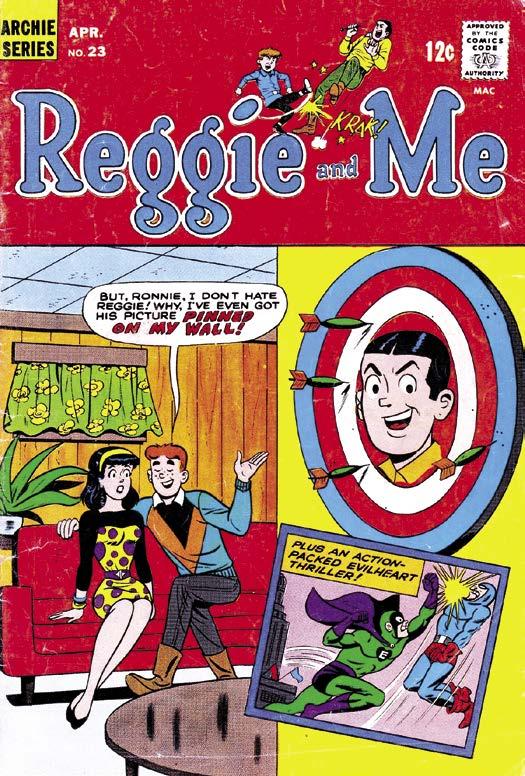
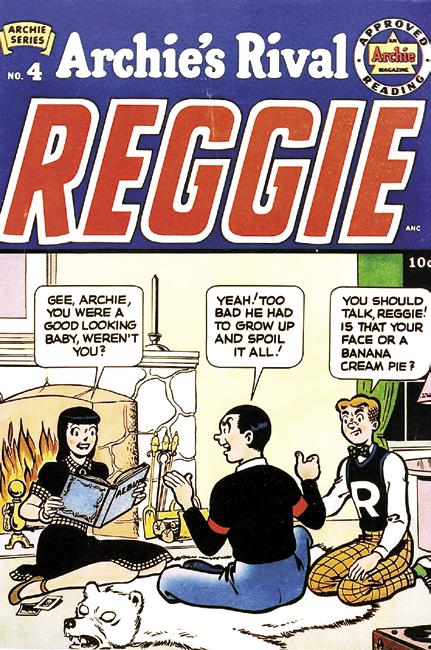
titles. The main Reggie title was originally called Archie’s Rival, Reggie, with #1 cover dated February 1950. The series was canceled with #15, August 1954, and then resumed in September 1963, quickly losing the “Archie’s Rival” part of the title. Reggie ended with #18, November 1965, Next, Reggie became Reggie and Me and resumed publication in August 1966. The Reggie and Me title stuck around for a while, finally ending with #125, September 1980.
The other main Reggie title, based on Archie’s Joke Book, was Reggie’s “Wise Guy” Jokes, which lasted for 55 issues from August 1968 through September 1980. The most recent attempt to do a Reggie-titled book was a series called Reggie’s Revenge which lasted for three issues from 1994-1995.
Both of these titles don’t really focus on the Archie-Reggie dynamic, especially the Jokes title; however, Reggie does feature as Evilheart in many of the Archie Captain Pureheart superhero stories which appear frequently in the early issues of Reggie and Me. These stories can be considered the ultimate version of the Archie-Reggie feud.
According to Don Markstein’s Toonopedia, “Life with Archie, launched in 1958 as one of the carrot-topped teen’s ancillary titles, tended to run longer, more adventure-oriented stories than the rest of the Archie Comics line. In the 42nd issue (Oct., 1965), at the suggestion of publisher John Goldwater, writer Frank Doyle (long-time Archie Comics contributor) and artist Bob White ( Cosmo the Merry Martian ) arranged for Archie to acquire super powers, put on a skin-tight costume, take on the name ‘Pureheart the Powerful,’ and do mighty battle with the forces of crime and/or evil. They posited a ‘PH (for Pure Heart) Factor,’ which Archie could invoke to give himself generic super powers (strength, flight, invulnerability), and pitted him against the super villain Ice Cube (billed on the cover as a ‘diabolical super-fink’). Afterward, the PH Factor blanked out the memory of everyone in the vicinity, including Archie.
“Pureheart was back two issues later, and back again in #s 46, 48 and 50. It was in the 46th issue that he got his origin story. #48 introduced the villain Evilheart, who was secretly
by Ed Lute


Many comic readers like to argue about various comic book minutiae such as who is stronger, the Thing or the Hulk, or who else can pick up Thor’s hammer, or who is the best Robin, or which publisher is better, Marvel or DC? For decades, comic book fans have pondered these questions amongst themselves with defenders standing their ground and with some fans maybe even offering convincing arguments to sway those on the fence. These arguments are usually purely for fun with no real objective way to come to a conclusion, but one question that fans have pondered for decades could be answered: Who is faster Superman or the Flash? That’s because the heroes’ friendly rivalry has graced the pages of comics for decades.
Back Issue takes you from the starting gate to the finishing line to offer you this fast-paced article (is there any other kind when you are talking about two of the fastest comic book characters?) that will examine their many four-color races and beyond. Come along for the photo finish of this storied but friendly competition.
THE STARTING LINE
Despite the fact that both Superman and the Flash have been around since the Golden Age of Comics, their first race didn’t take place until the Silver Age and towards the end of the age at that. Thus, it wasn’t the original Golden Age Flash Jay Garrick but the Silver Age Flash Barry Allen, who debuted in Showcase #4 (Oct. 1956), that first faced off against the Man of Steel in a race around the world for charity in Superman #199 (Aug. 1967).
If you thought the premise sounded like it could have come from the imagination of a comic book fanboy, you would be correct and with the emphasis .” Writer Jim Shooter’s first published story appeared when he was only 14 years old. So, he was still a teenager when this Superman issue that he wrote appeared the following year. The young writer was given the keys to one of the most popular comic books of the time and used that freedom to bring this story to life. Not surprising either is that this idea had been percolating for years even before Shooter started writing for DC. In TwoMorrows’ The Krypton , Shooter stated, “My idea, but way before I was a teenager. I think I was about six years old when Julius Schwartz and company revived the Flash. Cool. I immediately wondered who was faster. In my first-grade school tablet I used to draw pictures of the two of them racing.”
Don’t feel like racing around to find the individual issues mentioned in this article?
Just pick up the collected edition! Cover art Superman vs. The Flash: Seven of the Greatest Races of All Time! by Alex Ross.
TM & © DC Comics.
(left) The race begins! Cover by Carmine Infantino and Murphy Anderson. Original art scan courtesy of Heritage Auctions (www.ha.com). (right) The race takes place on all kinds of terrain. Art by Curt Swan and George Klein.
For readers, the excitement started even before they opened the book because of the iconic cover by artist Carmine Infantino. The heroes appear to be ready to run right off of the kinesthetic cover. Inside, it was artists Curt Swan and George Klein who delivered the action.
In the story, such a high-profile race brought in many illegal bets. The American mob bet heavily on Superman to win, while the European mob backed the Flash. Each side created obstacles so their respective superhero would win. In the end, the heroes decided that the race should end in a tie so that neither mob would profit. It’s a good thing that Shooter brought the childhood wonderment with him to the Superman book because this story set off a series of Superman and Flash races.
Since this story didn’t get a chance to answer the question that fans wanted to know, maybe the next story in this fast-paced rivalry would. Readers wouldn’t have to wait long for the rematch because it took place just four months later in the pages of Flash #175 (Dec. 1967).

Another action-packed cover by Infantino (this time accompanied by inker Mike Esposito) greeted readers as they perused the comic book racks. Writer E. Nelson Bridwell and artists Ross Andru and Esposito were the creative team for the second race between the heroes. This time the stakes were higher than just earning money for charity as two aliens forced the heroes to race across the Milky Way with the loser watching his home city be destroyed. In the end, the heroes defeated the aliens who were revealed to be Flash villains, the 25th century speedster Reverse-Flash and Abra Kadabra, who hailed from the 64th century. Unfortunately, the race ended without a winner being declared. Bridwell hedged his bets that fans of both heroes would want to see their favorite win this contest, so he left it up to them to decide who had actually won the race.
Would readers ever get a definitive answer to their burning question? Let’s race into the Bronze Age and see!
RACING INTO THE BRONZE AGE
As the Bronze Age of Comics dawned, more Superman and Flash races were on the horizon. However, the next two races wouldn’t appear in either a solo Flash or Superman comic, but in World’s Finest Comics (a title that began as a Superman and Batman book, but with this issue temporarily changed into a Superman team-up title) and DC Comics Presents (a Superman team-up book). Even with the move, these races continued to thrill readers. From the far reaches of outer space to the tides of time, the races of the Bronze Age took the heroes to new heights.

The two-parter from World’s Finest Comics #198-199 (Nov.–Dec. 1970) featured the heroes attempting to save a time-displaced Jimmy Olsen by racing in opposite directions to help reverse the effects. They decided to make it a competition. The story also gave readers something that the previous ones did not—one of the heroes was finally declared a winner.
Writer Martin Pasko (who would go on to write for DC Comics including a Superman and Flash race) wrote a fan letter regarding issue #198 that was published in issue #202. He opined, “‘Race to the Save the Universe’ was one of the most refreshing stories to be had in any comic publication in quite some time, much less a member of the Superman line!
“On page 13, we see four mysterious characters carrying off an unconscious Superman. Die-hard Supermaniacs will recognize these men as Jax-Ur and company, the Phantom Zone villains. If the Arachnoid menace is indeed a plot hatched from the Phantom Zone, then author Denny O’Neil has produced the most imaginative, inventive, and absorbing use of sophomorically treated other-dimensional prison-world ever.
“There is so much to this story that was original, exciting, and joyous to behold that it can’t all be set down in one letter. The inclusion of the Guardians, the digression into the ‘other-dimension,’ the clever device of the color-changing sun (which, however, changed color at intricate moments that were too coincidental for comfort), and Jimmy Olsen’s nerve-wracking plight (serving as a tension-intensifying sub-plot) were the many elements that made up the myriad joys of WF 198.
“It is a credit to author O’Neil that he, unpredictable writer (who can prompt you to say nice things about him and then make you look like an idiot the next issue) that he is, managed to subdue the slightly campy dialogue he likes to inject sometimes and the credulity-straining sequences (like the ‘oh-yes-while-we’re-at-it…’ type of approach to getting Flash and Superman to stage a race) enough to produce a fine, tightly-written yarn. It’s unfortunate that the Whose-faster-Superman-or-Flash nonsense had to creep into the wonderful plot.”
On the same letter page, editor E. Nelson Bridwell told readers why this story was published, “Do the readers even care about which hero is faster?!? It was a flood of letters reproving us for hedging on the outcome in past issues that prompted us to renew the contest.”
Issue #199 contained the end of the tale, but it was the end of the race that was probably the talk of the playgrounds at the time. DC finally gave fans what they wanted when one of the heroes was finally declared the winner as the Flash crossed the finish line first.
Not to be outdone by O’Neil’s story, artists Curt Swan (#198) and Neal Adams (#199) continued the trend of outstanding cover artwork for these matchups. Dick Dillin and Joe Giella produced exciting interior artwork.
In DC Comics Presents #1-2 (Aug – Oct. 1978), Pasko (now the writer) had the heroes run across time. However, he wasn’t as excited about the dynamics behind the race as he was about their previous race. In a 2018 comment on the BACK ISSUE Facebook page, he wrote, “[Editor Julius Swartz] kept poking holes in the ‘logic’ of a story he demanded, and which I didn’t want to write in the first place. But I was under contract, so, past a certain point I couldn’t say ‘no.’ My attitude towards the time-paradox story is ‘Please don’t make me write that sh*t, it never ‘works.’ It never makes sense to rational people…’ Ray got real close to it with ‘A Sound of Thunder,’ but who the hell else is Ray Frickin’ Bradbury?

(top) It’s the first rematch between the Flash and Superman. Cover by Carmine Infantino and Mike Esposito. (bottom) Superman and Flash engage in a literal space race. TM & © DC Comics.


by Doug Zawisza

“I wonder why they call it a poker hand, hm?”
The Beast (Hank McCoy of the X-Men and, at the point Marvel Two-in-One #51 (May 1979) was published, an Avenger) posits some poker philosophy for his card-playing colleagues (and us readers!) to consider as he gazes upon the cards he holds with his right foot. The Floating Poker Game as it has come to be known, debuts in MTIO #51. While it hasn’t been as prevalent as Wolverine being the best there is at what he does, or the Thing shouting out, “IT’S CLOBBERIN’ TIME!,” the heroic hold ’em hoopla has become a grand tradition Marvel fans revel in whenever and wherever it pops up. And before you fire up the letters to the editor, I am aware that Texas Hold’em is not the usual flavor of poker popping up in Marvel Comics, but the alliteration worked better than anything I could write centered around “five-card stud.”
Showcasing the connectivity of the Marvel Universe, Marvel Two-in-One #51 delivers a cover
comparable to any team comic on the rack, promising a team-up featuring a gathering of heroes including guest stars the Beast, Ms. Marvel, Nick Fury, and Wonder Man as they all charge the reader. Gorgeously drawn by George Pérez and inked by Joe Sinnott, the cover of MTIO #51 is a sight to behold, jam-packed with the promise of awesome adventures within.
While each of the characters mentioned above get their own logo treatment on the cover, “Full House—Dragons High” is billed internally as a team-up between the Thing and the Avengers. The cover co-stars—Thing, Beast, Ms. Marvel, Nick Fury, and Wonder Man—are joined inside by Avengers’ butler, Edwin Jarvis, and Marvel Comics’ New York City District Attorney Blake Tower. Written by Peter Gillis, drawn by Frank Miller, inked by Bob McLeod, lettered by Tom Orzechowski, and colored by Glynis Wein, the interiors deliver
Grab a seat at the table, it’s time to play. From Marvel Two-in-One #51. Art by Frank Miller and Bob McLeod. TM & © Marvel Characters, Inc.


on the promise, giving the reader everything from the Thing being put in his place verbally by both Wonder Man and Jarvis to an impromptu pause of the poker shenanigans in exchange for a super heroic slugfest as the inevitable supervillain attack breaks out.
As BACK ISSUE editor-in-chief emeritus Michael Eury summarizes Marvel Two-inOne #51 in his ultimate guide to team-up comics, The Team-Up Companion , “This being the Marvel Universe, however, poker nights, like wedding days, were magnets for trouble…and in this case a rogue military officer with a mad-on at S.H.I.E.L.D. was the antagonist who was not quite playing with a full deck.”
Sheesh. Weddings, birthday parties, poker games - can’t a hero ever catch a break without some riff-raff tryin’ ta take over da world?
I’m sure weddings and birthday parties have been covered elsewhere in the grand history of BACK ISSUE , so pull up a chair, grab your favorite snacks, pour yourself a beverage, and let’s regale one another in past hands dealt as we take a look at the Floating Poker Game.
What are ya waiting for? Cut the deck and turn the page already!
(left, top and bottom) Stakes are high around the poker table. Art by Frank Miller and Bob McLeod. (right) Heroes gather—to play poker! Cover art to Marvel Two-in-One #51 by George Pérez and Joe Sinnott.

According to “Two-Fisted Tom” (as Tom DeFalco recalls Jim Shooter dubbing him during a real-world round of poker) the game in Marvel Two-in-One #51 had its own secret origin.
“The floating poker game that appeared in a few Marvel Comics was actually based on a real weekly poker game that was usually hosted by Paul Levitz and Martin Pasko in the apartment they shared,” DeFalco revealed during a recent email exchange, “Regulars at the game included Jim Shooter, Len Wein, Marv Wolfman, Mike Barr, Al Milgrom, Jack Abel, and myself.”
Future Marvel Universe poker games would include at least one of the players from MTIO #51, and, more often than not, more than one. A grand new tradition in the mighty Marvel manner to be sure!
Surprisingly, the Floating

Poker Game makes a return in Marvel Two-inOne #56 (Oct. 1979), thanks to well-known comic book writer Kurt Busiek. Well, at least before he was a comic book writer. Busiek is known to have popped up in a letters page or seven, but regarding MTIO #51 specifically, he wrote, “Every so often a comicbook [sic] comes along that communicates something so powerful, so important, that fandom must hail that comic as a classic. Marvel Two-in-One #51 was not one of those comics.”
Not the most glowing endorsement, but Busiek continues, highlighting the real reason most folks read comics in the 1970s by adding, “It should, however, still be considered a classic because it had one thing going for it that set it apart from most other comics with great


(top) Carol Danvers cleand the boys out in Marvel Two-inOne #51. Art by by Frank Miller and Bob McLeod. (bottom, left and right) It never fails. You get a good hand, and suddenly there’s an emergency. Art by Alan Kupperberg and Chic Stone.
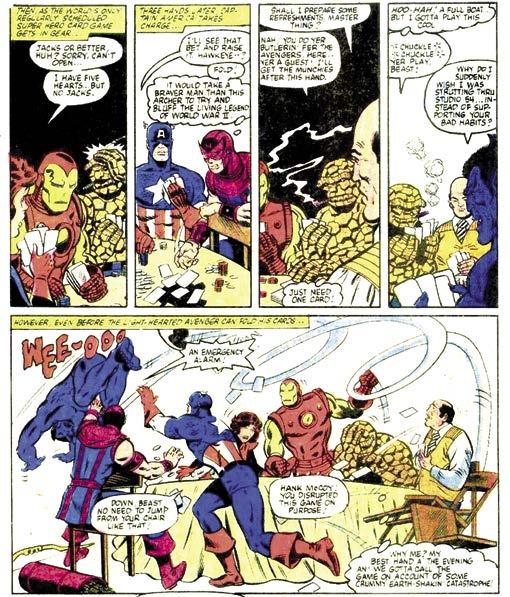
by

In this corner, wearing his classic blue and yellow sailor shirt with its matching cap and a red bow tie, the one, the only, Donald Duck! Not the “fictional” Donald Duck of the Walt Disney cartoons, this is rather the Barksian everyman (everyDUCK?). We don’t really need to go over Donald Duck’s history, do we? While the brilliant and long unknown writer/artist Carl Barks didn’t create Donald, he is to be credited for completely redefining the short-tempered, blustery character seen on the screen to work in the context of comic book stories.
While continuity in Disney comic books has never been strict, Donald is generally depicted as an oldfashioned guy, just trying to get along in Duckburg, court his girl, and raise his three nephews—Huey, Dewy, and Louie. On a regular basis, however, he’s interrupted by his ultra-rich, Uncle Scrooge McDuck, who sends him, or takes him along, on adventures all over, under, and sometimes above the world! Barks also, in late 1947, created Donald’s cousin, Gladstone Gander. A “gander,” of course, is not a duck at all, but rather a goose.
There he is now, over in the other corner, dapper in violet and curls, Gladstone Gander, a fellow to whom the laws of probability have never applied. The inherently lazy but stylish Gladstone has rarely had to work a day of his charmed life as lady luck incessantly rolls her dice in his favor, often in the most unlikely ways. One might think the character was inspired by the phrase, “you lucky goose,” but in the beginning, Gladstone’s defining gift had not yet been conceived. He was simply a cousin who, the reader was informed, had always attempted to get the better of Donald…and usually did. For more than seven decades now, Donald and Gladstone have been at odds nearly every time they meet.
Donald resents Gladstone for having it so easy while he has to struggle and kowtow to Scrooge’s every whim at a moment’s notice. Gladstone resents Donald for leading the perfectly normal life he himself has never been able to have.
While the characters were already shown as somewhat antagonistic rivals, it wasn’t until the Barks story “Race to the South Seas,” ( March of Comics #41, 1949) that we learned of Gladstone’s supernatural hold over the laws of fortune. Surprisingly, outside of the Barks hardcovers, this story wasn’t available in actual comics format again until Gemstone’s Donald Duck Adventures #26 (July 1992).
After that, and throughout the 1950s, Gladstone and Donald squared off regularly in several titles, even coming to physical blows off-panel in Walt Disney’s Comics and Stories #117 (June 1950), which left them with two black eyes each!
Donald and Gladstone nearly come to blows on the cover of Gladstone Comic Album #15. Art by Daan Jippes.
(left) The first appearance of Gladstone Gander from Walt Disney’s Comics and Stories #88. Art by Carl Barks. (right) One example of Gladstone’s luck from “Race to the South Seas!” in March of Comics #41.
reserved.
Gladstone also appeared in a series of stories in Dell’s semi-regular Four-Color Comics title in which Donald often didn’t appear at all. Gladstone pits his luck against Scrooge in an effort to acquire a rare painting in one story. In another, he sells good luck charms to Daisy and all the other women in Duckburg who are entering a baking contest. In yet another, Scrooge attempts to outwit Gladstone’s mastery of chance in order to claim a rare silver dollar in his nephew’s possession. Gladstone even aspires to be a bullfighter in one, only to run up against a friendly, Ferdinand-like bull. We even meet, briefly, Shamrock Gander, Gladstone’s young nephew who proves that the luck gene runs in the Gander family!

In 2009, Dark Horse Comics, under license from Disney, produced a series of collectible Syroco-style statues of Donald, Gladstone, and other ducks, all designed by writer/artist and
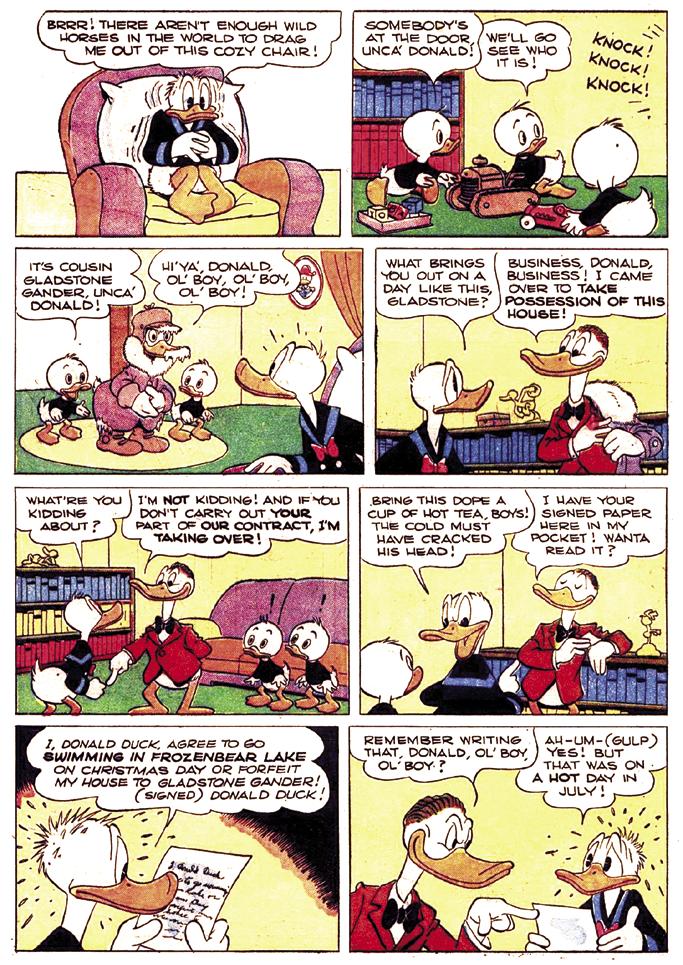
comics historian Craig Yoe. With tongue firmly in cheek, Yoe tells us, “When I was a tender age, my dear old mother got me a subscription to Walt Disney’s Comics and Stories. With that, she unwittingly started me on my road to ruin: a comic book addiction. I was especially hooked on the Donald vs Gladstone battles. I later berated “pusher-man” Carl Barks when we were both guests at a Disneyana convention. I told that bad duck artist I couldn’t live without reading and re-reading his stories, like the one where Donald and Gladstone ruthlessly fought to win a prize for growing the best apples. Pity me, Bark’s gateway duck and that damn charmed goose caused me to spiral down to become strung-out on harder drugs like the Thing vs. the Hulk. I myself was one unlucky duck, but may my downfall be a stern warning to all!”
One of the best-known stories highlighting the rivalry of the avian cousins is “Luck of the North.” Originally presented in a Donald Duck issue of Dell’s Four-Color Comics (#256, Dec. 1949), this exciting 32-page Carl Barks epic has been reprinted in the US in 1967, 1973, 1986, 1990, and 2010! The story starts off slowly, with Donald randomly bumping into Gladstone. The latter suggests that the two hang out together so that the former can witness his much-vaunted luck in action. He finds wallets, wins raffles, and when a creditor threatens to beat him up if not paid $5.00 immediately, the wind blows a $10 bill into his hand, so he not only pays his debt but gets change. Sick and tired of watching it all unfold so effortlessly, Donald fakes



by James Heath Lantz
One of the greatest rivalries in the Marvel Universe is that of the Ever-Lovin’ Blue-Eyed Thing and Incredible Hulk. Since their first encounter way back in the March 1963, these two gargantuan powerhouses have been duking it out for more than half a century in various Marvel periodicals. It’s clobbering and smashing time as we take look at the BACK ISSUE era Hulk and Thing bouts. Just watch out for any debris while reading on, True Believers.
SMASHING HISTORY
Sharing a universe isn’t new in comic books. The various members of the Justice Society of America met regularly for adventures while also having solo outings in numerous comic books, and the Sub-Mariner battled the Human Torch in what is considered the first major crossover of the medium. These events occurred in the Golden Age. However, Stan Lee and Jack Kirby made the concept more prominent roughly two decades later when the Fantastic Four took on the Incredible Hulk in Fantastic Four #12. That issue started the rivalry between the Green Goliath and Benjamin J. Grimm, better known as the Fantastic Four’s Thing. Their actual first battle lasted only a few panels. Yet, fans wanted more. They got their wish in FF #25-26, (Apr.-May 1964) a story that was too big for a single issue. While the Thing and the rest of the Fantastic Four fought hard, they also needed help from the Avengers to battle the Hulk. The Thing would take on the Hulk again in Incredible Hulk #122 (Dec. 1969) when Bruce Banner sought Reed Richards’ assistance in one of his many attempts to cure himself of his green alter ego.
Starting out, the Thing and the Hulk’s fights could be seen as the Marvel equivalent of Godzilla or Gamera films in which the title creatures must combat another gigantic monster. Yet there was, and still is, something more to their clashes than that. Both the Thing and the Hulk were just starting out in their respective adventures in the Silver Age, and they were perceived as monsters upon people seeing them for the first time. Yet, Ben Grimm was eventually accepted by mankind because of his willingness to be part of the Fantastic Four. However, the Hulk, while also seeking acceptance, tended to lock horns with other founding members of the Avengers and the rest of the Marvel Universe. The Thing often disagreed with the other members of the Fantastic Four, particularly the Human Torch, who teased poor Ben Grimm. Yet, his sparring with Marvel’s First Family is generally more good-natured. The Hulk tends to be more unpredictable when interacting with others (perhaps due to Bruce Banner’s later diagnosed Dissociative Identity Disorder caused by his father’s abuse). Now, Ben
A classic Thing vs. Hulk image from the cover of Fantastic Four #112 by John Buscema and Frank Giacoia.
TM & © Marvel Characters, Inc.
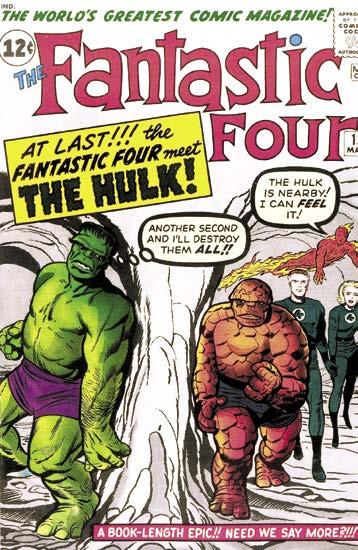
(left) The first round in the battle was fought in Fantastic Four #12. Cover by Jack Kirby and Dick Ayers. (middle) The Thing and the Hulk are back at it again in Fantastic Four #25. Cover by Jack Kirby and George Roussos. (right) This time, the Thing comes to the Hulk’s comic. Cover by Herb Trimpe.

Grimm’s childhood was not a bed of roses. His family lived in poverty, and his parents and brother died. Yet, the love and nurturing from his Uncle Jake and Aunt Petunia helped prevent Ben from being as, for lack of a better term, mentally fractured as Bruce.
BRONZE AGE BOUTS
If you thought the Hulk and the Thing’s rivalry mellowed in the BACK ISSUE era of comic books, you’d be quite mistaken, dear reader. Case in point, Fantastic Four #111-112. (June-July 1971) In most cases of their fights, the Thing must stop the Hulk’s rampages. However, the Thing is the one running amok in these issues. The last page of #111 and the entirety of #112 consist of “The Battle Of The Behemoths.” Reed Richards’ experiment to help Ben Grimm transform from the Thing to a human and back again has failed, causing Ben to rage through the streets of New York. Reed needs Bruce Banner’s help to see where he went wrong, but a cab ride to Baxter Building is cut short when Banner sees the Thing and becomes the Hulk. Both gargantuan heroes get their punches in, but the advantage is the Hulk’s when the Thing notices that debris from their tussle is about to hit his girlfriend, Alicia Masters. The Hulk knocks out the Thing with the final panel leading into the next issue.
In the Silver and early Bronze Ages and beyond, much of the Hulk and the Thing’s conflict with one another looks like a contest of which character is stronger. Sure, the Thing often tries to prove he can beat the Hulk, and he has, from time to time, come out on top. Yet, the matches and re-matches are close ones. The Thing, normally, is determined to stop the Hulk’s rampages. Yet, one thing sometimes kept the Thing from winning. The Hulk is more of a force of nature, a being full of rage. Basically, this makes the Jade Giant the victorious one because the angrier the Hulk gets, the stronger he becomes.
The next match on our bout sheet took place in Incredible Hulk #153 (July 1972). Gary

Friedrich, Roy Thomas, Dick Ayers, Herb Trimpe, and John Severin tell a tale of the Hulk on trial. The Fantastic Four, Daredevil, and Spider-Man must all take on the green skinned powerhouse. Yet, as Ben Grimm points out, even the Thing’s strongest punch doesn’t seem to faze the Hulk.
Incredible Hulk #153 displays something that is common throughout the early Bronze Age issues in the series—the Hulk’s feelings of being betrayed by friends. That’s not to say the Thing has not had such things happen to him. He has. The Hulk, particularly the savage green persona, represents Bruce Banner’s childhood need to be accepted and liked in spite of the Hulk at times saying that he wants to be left alone.
Jim Starlin, perhaps best known for the creation of Marvel’s Thanos, refereed the Hulk and the Thing’s fights on three different occasions. In Marvel Feature #11 (Sept. 1973), a precursor to the Marvel Two-In-One title by Starlin and Len Wein, Kuurgo, last seen in Fantastic Four #7, and the Hulk’s old foe the Leader have staged a contest between Ol’ Greenskin and the Thing. As with many villains’ plans, it backfires, and the Hulk and the Thing put aside their differences to return home from the planet New Xanth.
Starlin’s second ringside seat went beyond the standard monthly format Fantastic Four, Marvel Two-In-One, and Incredible Hulk with Marvel Fanfare #20 and 21’s “Clash”. (May-July 1985) Doctor Strange needs the Thing’s help fighting creatures under the command of Strange’s old foe Xandu. By the first chapter’s conclusion, Ben and Doctor Strange discover Xandu has taken the mindless Hulk from the Crossroads dimension where Strange had banished him in Incredible Hulk #300, using the Green Goliath as a pawn in his battle against the Master of the Mystic Arts.
Instead of having the two powerhouses fight each other in Starlin’s third outing, he and Bernie Wrightson would have them in a somewhat

uneasy alliance in the graphic novel The Incredible Hulk and The Thing: The Big Change (1987). Regular BACK ISSUE readers will recall that The Big Change and other Marvel Universe graphic novels were discussed in BI #156. Starlin, according to his interview with Comic Book Historians.com, had a lot of fun working on that with Bernie Wrightson, who preferred working in the DC Comics style of full script rather than the Marvel one of the plot. Wrightson also contributed to the story with his ideas and visuals. One example of this occurs when the Thing and the Hulk must be in disguise, and the Hulk merely puts an octopus-like creature on top of his head. That bit of comedic action feels like something out of a Peter Sellers movie. Yet, Starlin and Wrightson make it work perfectly with the graphic novel’s overall tone. That’s not to say that Ben and Hulk don’t hold a grudge against one another. They do. This is particularly shown in the scenes on Earth that bookend The Big Change
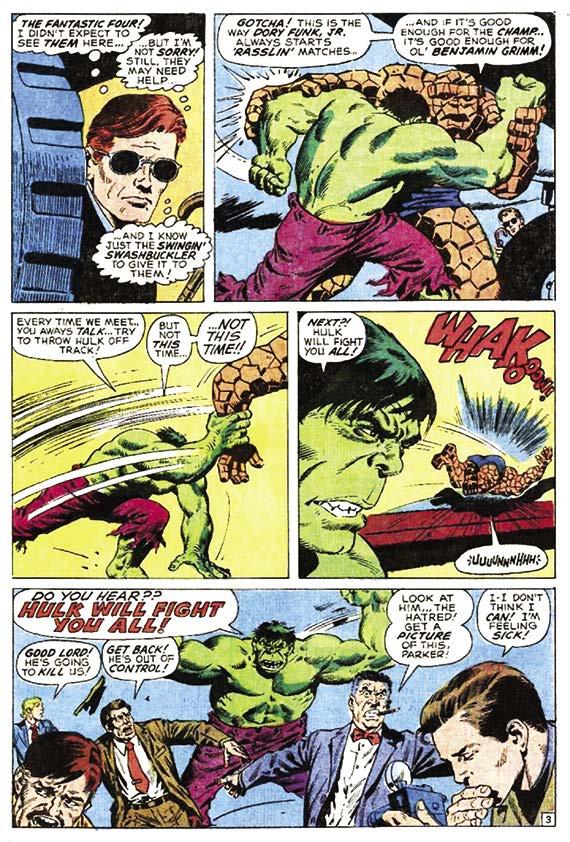
growls of the Hulk in the live action series The Incredible Hulk starring Bill Bixby and Lou Ferrigno that aired on CBS in the same period.
IF YOU ENJOYED THIS PREVIEW, CLICK THE LINK TO ORDER THIS ISSUE IN PRINT OR DIGITAL FORMAT!
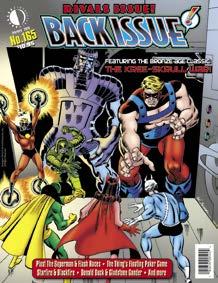
Like Starlin and Wrightson in The Big Change writer/artist Alan Kupperberg put a lighthearted spin on the Thing and Hulk’s rivalry. Kupperberg did so in Marvel Two-In-One at a time when both characters could be seen on television. NBC had broadcast the 1978 The New Fantastic Four animated series starring Ted “Lurch” Cassidy as the Thing. Cassidy also would provide the famous opening credits’ narration and the snarls and
Marvel Two-In-One #46 (Dec. 1978) and Annual #5 (Sep. 1980) were Kupperberg’s take on the Thing and the Hulk’s clashes. Annual #5 has the Hulk and Thing help the Stranger fight Pluto in order to save their catatonic loved ones in a tale that is similar to Marvel Feature #11. It has its share of laughs here and there. Yet, it’s “Battle in Burbank” from Marvel #46 that puts a truly humorous spin on Ben Grimm’s fights with the Green Goliath.
BACK ISSUE #165
The Hulk and the Thing are both angry about Incredible Hulk TV series, albeit for different reasons. Ben is wondering why the Hulk got a show instead of him, and the Hulk doesn’t like having a series about his life. This leads the two main characters to once again punch each other a bunch while increasing Hollywood studios’ insurance rates. Many of the jokes function perfectly while being products of their time. For example, Ben stars in A Thing In The Family in the comic book’s conclusion. This spoofs Norman Lear’s All In The Family with the Thing playing a parody of Rob Reiner’s Michael “Meathead” Stivic character. All In The Family, an American version of Britain’s Till Death Us Do Part, ran on CBS from 1971 until 1979 and was popular when Marvel Two-In-One #46 was produced and published.
(left) The Thing and Hulk go at it in Fantastic Four #112. Art by John Buscema and Joe Sinnott. (right) The Hulk and the Thing trade blows in Incredible Hulk#153. Art by Dick Ayers and John Severin.
